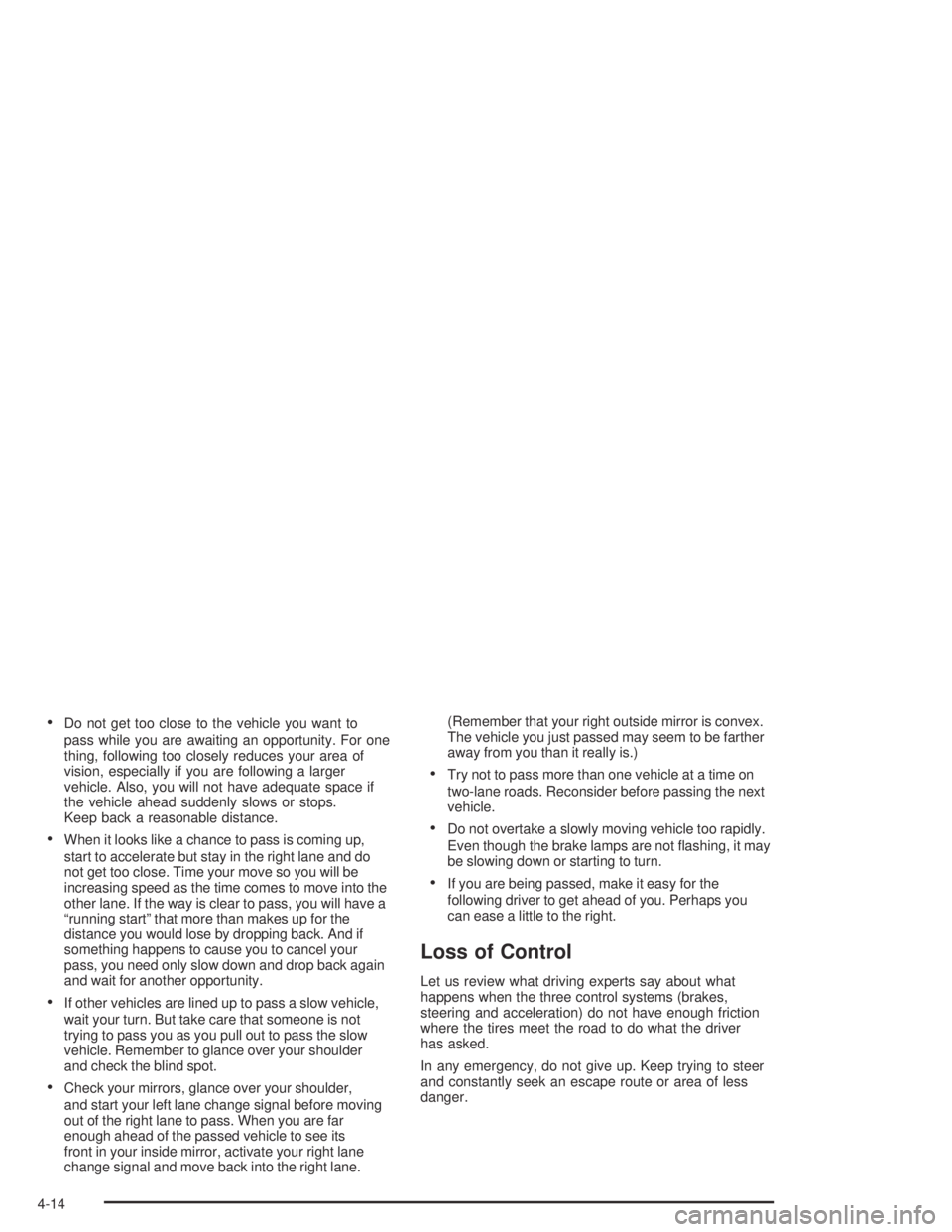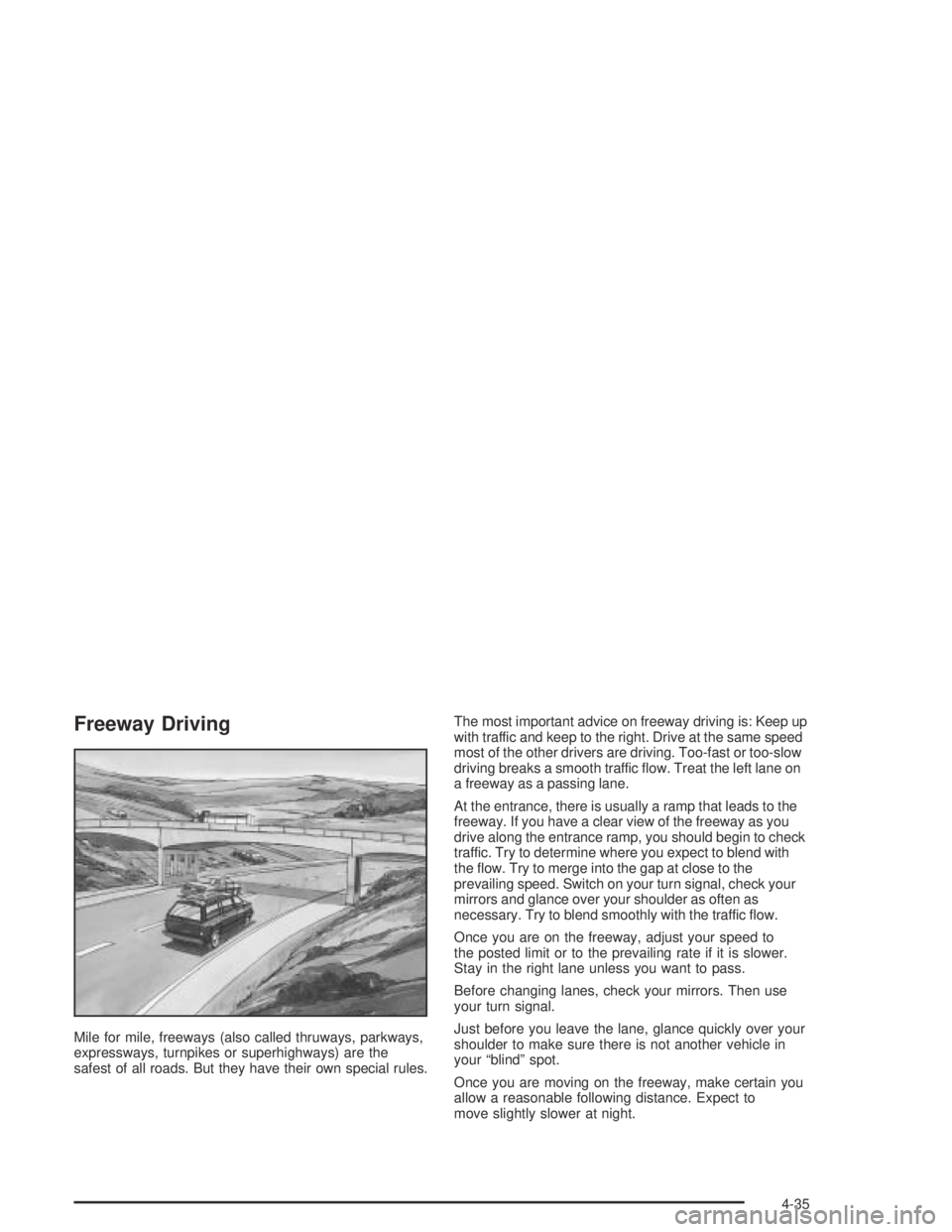2004 GMC ENVOY XL mirror
[x] Cancel search: mirrorPage 256 of 466

Do not get too close to the vehicle you want to
pass while you are awaiting an opportunity. For one
thing, following too closely reduces your area of
vision, especially if you are following a larger
vehicle. Also, you will not have adequate space if
the vehicle ahead suddenly slows or stops.
Keep back a reasonable distance.
When it looks like a chance to pass is coming up,
start to accelerate but stay in the right lane and do
not get too close. Time your move so you will be
increasing speed as the time comes to move into the
other lane. If the way is clear to pass, you will have a
“running start” that more than makes up for the
distance you would lose by dropping back. And if
something happens to cause you to cancel your
pass, you need only slow down and drop back again
and wait for another opportunity.
If other vehicles are lined up to pass a slow vehicle,
wait your turn. But take care that someone is not
trying to pass you as you pull out to pass the slow
vehicle. Remember to glance over your shoulder
and check the blind spot.
Check your mirrors, glance over your shoulder,
and start your left lane change signal before moving
out of the right lane to pass. When you are far
enough ahead of the passed vehicle to see its
front in your inside mirror, activate your right lane
change signal and move back into the right lane.(Remember that your right outside mirror is convex.
The vehicle you just passed may seem to be farther
away from you than it really is.)
Try not to pass more than one vehicle at a time on
two-lane roads. Reconsider before passing the next
vehicle.
Do not overtake a slowly moving vehicle too rapidly.
Even though the brake lamps are not �ashing, it may
be slowing down or starting to turn.
If you are being passed, make it easy for the
following driver to get ahead of you. Perhaps you
can ease a little to the right.
Loss of Control
Let us review what driving experts say about what
happens when the three control systems (brakes,
steering and acceleration) do not have enough friction
where the tires meet the road to do what the driver
has asked.
In any emergency, do not give up. Keep trying to steer
and constantly seek an escape route or area of less
danger.
4-14
Page 257 of 466

Skidding
In a skid, a driver can lose control of the vehicle.
Defensive drivers avoid most skids by taking reasonable
care suited to existing conditions, and by not “overdriving”
those conditions. But skids are always possible.
The three types of skids correspond to your vehicle’s
three control systems. In the braking skid, your wheels
are not rolling. In the steering or cornering skid, too much
speed or steering in a curve causes tires to slip and lose
cornering force. And in the acceleration skid, too much
throttle causes the driving wheels to spin.
A cornering skid is best handled by easing your foot off
the accelerator pedal.
If you have the Traction Assist System, remember: It
helps avoid only the acceleration skid. If you do not have
this system, or if the system is off, then an acceleration
skid is also best handled by easing your foot off the
accelerator pedal.
If your vehicle starts to slide, ease your foot off the
accelerator pedal and quickly steer the way you want
the vehicle to go. If you start steering quickly enough,
your vehicle may straighten out. Always be ready
for a second skid if it occurs.Of course, traction is reduced when water, snow, ice,
gravel or other material is on the road. For safety,
you will want to slow down and adjust your driving to
these conditions. It is important to slow down on slippery
surfaces because stopping distance will be longer and
vehicle control more limited.
While driving on a surface with reduced traction, try
your best to avoid sudden steering, acceleration
or braking (including engine braking by shifting to a
lower gear). Any sudden changes could cause the tires
to slide. You may not realize the surface is slippery
until your vehicle is skidding. Learn to recognize warning
clues — such as enough water, ice or packed snow
on the road to make a “mirrored surface” — and slow
down when you have any doubt.
Remember: Any anti-lock brake system (ABS) helps
avoid only the braking skid.
4-15
Page 277 of 466

Freeway Driving
Mile for mile, freeways (also called thruways, parkways,
expressways, turnpikes or superhighways) are the
safest of all roads. But they have their own special rules.The most important advice on freeway driving is: Keep up
with traffic and keep to the right. Drive at the same speed
most of the other drivers are driving. Too-fast or too-slow
driving breaks a smooth traffic �ow. Treat the left lane on
a freeway as a passing lane.
At the entrance, there is usually a ramp that leads to the
freeway. If you have a clear view of the freeway as you
drive along the entrance ramp, you should begin to check
traffic. Try to determine where you expect to blend with
the �ow. Try to merge into the gap at close to the
prevailing speed. Switch on your turn signal, check your
mirrors and glance over your shoulder as often as
necessary. Try to blend smoothly with the traffic �ow.
Once you are on the freeway, adjust your speed to
the posted limit or to the prevailing rate if it is slower.
Stay in the right lane unless you want to pass.
Before changing lanes, check your mirrors. Then use
your turn signal.
Just before you leave the lane, glance quickly over your
shoulder to make sure there is not another vehicle in
your “blind” spot.
Once you are moving on the freeway, make certain you
allow a reasonable following distance. Expect to
move slightly slower at night.
4-35
Page 279 of 466

Highway Hypnosis
Is there actually such a condition as “highway hypnosis”?
Or is it just plain falling asleep at the wheel? Call it
highway hypnosis, lack of awareness, or whatever.
There is something about an easy stretch of road with the
same scenery, along with the hum of the tires onthe road,
the drone of the engine, and the rush of the wind against
the vehicle that can make you sleepy. Do not let it happen
to you! If it does, your vehicle can leave the road in
less than a second,and you could crash and be injured.What can you do about highway hypnosis? First, be
aware that it can happen.
Then here are some tips:
Make sure your vehicle is well ventilated, with a
comfortably cool interior.
Keep your eyes moving. Scan the road ahead and
to the sides. Check your mirrors and your
instruments frequently.
If you get sleepy, pull off the road into a rest,
service or parking area and take a nap, get some
exercise, or both. For safety, treat drowsiness
on the highway as an emergency.
4-37
Page 304 of 466

Before you start, check all trailer hitch parts and and
attachments, safety chains, electrical connection, lamps,
tires and mirror adjustment. If the trailer has electric
brakes, start your vehicle and trailer moving and then
apply the trailer brake controller by hand to be sure
the brakes are working. This lets you check your
electrical connection at the same time.
During your trip, check occasionally to be sure that the
load is secure, and that the lamps and any trailer
brakes are still working.
Following Distance
Stay at least twice as far behind the vehicle ahead as
you would when driving your vehicle without a trailer.
This can help you avoid situations that require
heavy braking and sudden turns.
Passing
You’ll need more passing distance up ahead when
you’re towing a trailer. And, because you’re a good
deal longer, you’ll need to go much farther beyond the
passed vehicle before you can return to your lane.
Backing Up
Hold the bottom of the steering wheel with one hand.
Then, to move the trailer to the left, just move that hand
to the left. To move the trailer to the right, move your
hand to the right. Always back up slowly and, if possible,
have someone guide you.
Making Turns
Notice:Making very sharp turns while trailering
could cause the trailer to come in contact with the
vehicle. Your vehicle could be damaged. Avoid
making very sharp turns while trailering.
When you’re turning with a trailer, make wider turns than
normal. Do this so your trailer won’t strike soft shoulders,
curbs, road signs, trees or other objects. Avoid jerky or
sudden maneuvers. Signal well in advance.
4-62
Page 458 of 466

In�ation - Tire Pressure...................................5-64
Instrument Panel
Cluster.......................................................3-36
Overview..................................................... 3-4
Instrument Panel Brightness.............................3-18
Interior Lamps................................................3-18
J
Jump Starting.................................................5-43
K
Keyless Entry System....................................... 2-5
Keys............................................................... 2-3
L
Lamps
Exterior......................................................3-16
Interior.......................................................3-18
Lamps On Reminder.......................................3-17
Lap-Shoulder Belt...................................1-14, 1-22
LATCH System
Child Restraints...........................................1-40
Securing a Child Restraint Designed
or the LATCH System...............................1-42Leaving Your Vehicle.......................................2-13
Leaving Your Vehicle With the Engine
Running.....................................................2-32
LEFT REAR DOOR AJAR................................3-63
Liftgate Release..............................................2-14
Liftgate/Liftglass..............................................2-14
Liftglass/Liftgate..............................................2-14
Light
Air Bag Readiness.......................................3-38
Anti-Lock Brake System Warning...................3-42
Brake System Warning.................................3-40
Change Engine Oil......................................3-47
Charging System.........................................3-39
Check Gages Warning.................................3-49
Cruise Control.............................................3-48
Gate Ajar...................................................3-49
Low Fuel Warning.......................................3-50
Malfunction Indicator....................................3-43
Reduced Engine Power................................3-48
Safety Belt Reminder...................................3-38
Security.....................................................3-47
Service Four-Wheel-Drive Warning Light.........3-48
Lighted Visor Vanity Mirror...............................2-17
Listening to a DVD................................3-91, 3-105
Loading Your Vehicle.......................................4-49
Loading Your Vehicle for Off-Road Driving..........4-17
Locking Rear Axle...........................................4-11
Lockout Protection..........................................2-13
8
Page 459 of 466

Locks
Delayed Locking..........................................2-10
Door........................................................... 2-8
Leaving Your Vehicle....................................2-13
Lockout Protection.......................................2-13
Power Door.................................................. 2-9
Programmable Automatic Door Locks.............2-10
Rear Door Security Locks.............................2-13
Loss of Control...............................................4-14
Low Fuel Warning Light...................................3-50
Luggage Carrier..............................................2-48
Lumbar
Power Controls............................................. 1-2
M
Maintenance Schedule
Additional Required Services........................... 6-6
At Each Fuel Fill.........................................6-10
At Least Once a Month................................6-10
At Least Once a Year..................................6-11
Introduction.................................................. 6-2
Maintenance Footnotes.................................. 6-8
Maintenance Record....................................6-16
Maintenance Requirements............................. 6-2
Normal Maintenance Replacement Parts.........6-15
Owner Checks and Services........................... 6-9
Recommended Fluids and Lubricants.............6-13
Scheduled Maintenance................................. 6-4Maintenance Schedule (cont.)
Using Your................................................... 6-3
Your Vehicle and the Environment................... 6-2
Maintenance When Trailer Towing.....................4-65
Making Turns.................................................4-62
Malfunction Indicator Light................................3-43
Matching Transmitter(s) to Your Vehicle............... 2-6
Memory Seat.................................................2-53
Message
DIC Warnings and Messages........................3-60
Mexico, Central America and Caribbean
Islands/Countries (Except Puerto Rico
and U.S. Virgin Islands)................................. 7-5
Mirror Operation.............................................2-36
Mirrors
Automatic Dimming Rearview with
OnStar®and Compass..............................2-36
Outside Convex Mirror.................................2-39
Outside Curb View Assist Mirrors...................2-39
Outside Heated Mirrors................................2-39
Outside Manual Mirrors................................2-38
Outside Power Mirrors..................................2-38
MyGMLink.com................................................ 7-4
N
Navigation/Radio System................................3-106
New Vehicle Break-In......................................2-19
Normal Maintenance Replacement Parts............6-15
9
Page 460 of 466

OOdometer......................................................3-37
Off-Road Recovery..........................................4-13
Oil
Change Engine Oil Light...............................3-47
Engine.......................................................5-16
Pressure Gage............................................3-46
OIL PRESSURE LOW/STOP
ENGINE.....................................................3-61
Older Children, Restraints................................1-27
Online Owner Center........................................ 7-4
OnStar
®Personal Calling.................................2-41
OnStar®Services............................................2-40
OnStar®System.............................................2-40
OnStar®Virtual Advisor....................................2-41
Operating Your All-Wheel-Drive Vehicle
Off Paved Roads.........................................4-16
Other Warning Devices...................................... 3-6
Outlet Adjustment...................................3-24, 3-30
Outside
Convex Mirror.............................................2-39
Curb View Assist Mirrors..............................2-39
Heated Mirrors............................................2-39
Manual Mirrors............................................2-38
Power Mirrors.............................................2-38
Overhead Console..........................................2-46
Owner Checks and Services.............................. 6-9
Owners, Canadian............................................... ii
Owner’s Information........................................7-13
PParental Control............................................3-106
Park (P)
Shifting Into................................................2-31
Shifting Out of............................................2-33
Parking
Brake........................................................2-29
Over Things That Burn.................................2-33
Parking on Hills..............................................4-64
PASSENGER DOOR AJAR..............................3-62
Passing.................................................4-13, 4-62
Passlock
®......................................................2-19
Personalization...............................................3-54
Personalization, Climate Controls......................3-34
Plan Ahead When Possible................................ 7-8
Playing a Cassette Tape..................................3-86
Playing a CD...............................3-74, 3-88, 3-100
Playing a Speci�c Loaded CD.........................3-101
Playing the Radio...........................3-66, 3-77, 3-93
Power
Accessory Outlets........................................3-21
Door Locks.................................................. 2-9
Electrical System.........................................5-96
Lumbar Controls........................................... 1-2
Reclining Seatbacks...................................... 1-4
Reduced Engine Light..................................3-48
Seat............................................................ 1-2
Steering Fluid.............................................5-37
Windows....................................................2-16
10